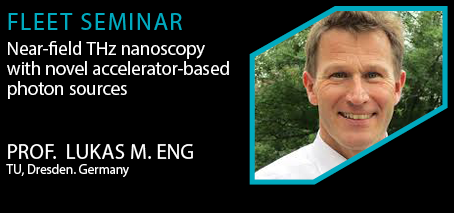-
28 Feb 2019
11:00 am - 12:00 pm
Near-field THz nanoscopy with novel accelerator-based photon sources
Prof. Lukas M. Eng. TU, Dresden. Germany
All welcome! The seminar flyer can be downloaded clicking on this link
Abstract:
This talk advertises scattering-type scanning near-field infrared nanospectroscopy (s-SNIM) in the spectral range of 75 to 1.3 THz [1], as provided by the free-electron laser FELBE at the Helmholtz-Zentrum Dresden-Rossendorf (HZDR), Germany. The FELBE narrow-band laser-light constitutes one of Germany’s accelerator-based laser light sources [2] that sails under the LEAPS consortium flag which has recently been established as the “League of European Accelerator-based Photon Sources (LEAPS) for advancing IR and X-ray science for next-generation material sciences down to nanometer and molecular length scales. This especially includes novel-type topological and polaritonic materials, profiting from their nanoscale investigation into prominent and novel applications.
When combining s-SNIM with FELBE, we demonstrate the λ-independent optical resolution down to ~10 nm only, by exploring structured Au samples, Graphene-transistors, meta-materials [3,4], and local-scale ferroic phase-transitions [5,6,7] down to LHe temperatures [8]; Moreover, also the non-linear responses at IR wavelengths can be explored as recently demonstrated when inspecting highly-doped GaAs/InGaAs core/shell nanowires [9]. s-SNIM secondly was integrated into a THz pump-probe setup for the inspection of excited states in structured SiGe samples. We developed a sophisticated demodulation technique that extracts pump-induced signals with a superior signal-to-noise ratio [10]. Thirdly, HZDR recently extended the available wavelength ranges down to 100 GHz radiation, employing the novel super-radiant TELBE light source [11]. We adapted our s-SNIM to this TELBE photon source as well, achieving an equally high spatial resolution as with FELBE. Moreover, the superb temporal resolution of TELBE allows us to locally explore a multitude of novel physical phenomena by s-SNIM with sub-cycle resolution [11,12], such as spin-structures, magnons and phonon polaritons.
References
[1] F. Kuschewski, LME, et al., Appl. Phys. Lett. 108 (2016) 113102.
[2] S.C. Kehr, LME, et al., Synch. Rad. News 30 (2017) 31.
[3] S.C. Kehr, LME et al., ACS Photonics 3 (2016) 20.
[4] M. Fehrenbacher, LME, et al., Nano Lett. 15 (2015) 1057.
[5] J. Döring, LME, and S. Kehr, J. Appl. Phys. 120 (2016) 084103.
[6] J. Döring, LME, et al., Appl. Phys. Lett. 105 (2014) 053109.
[7] A. Butykai, LME, et al., Sci. Rep. 7, (2017) 44663.
[8] D. Lang, LME, et al., Rev. Sci. Instrum. 89 (2018) 033702.
[9] D. Lang, LME, et al., Nanotechnology 30 (2019) 084003.
[10] F. Kuschewski, LME, et al., Sci. Rep. 5, (2015) 12582.
[11] B. Green et al., Sci. Rep. 6 (2016) 22256.
[12] S. Kovalev et al., Struct. Dyn. 4 (2017) 024301.
Venue: G59-G60, Old Main Building K15
Address:

